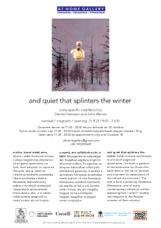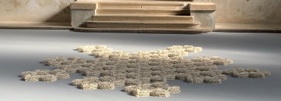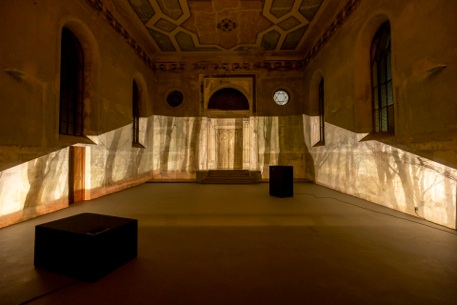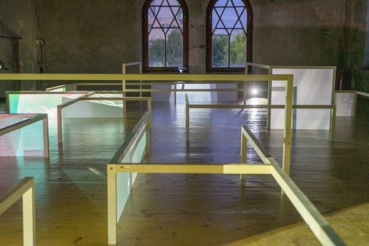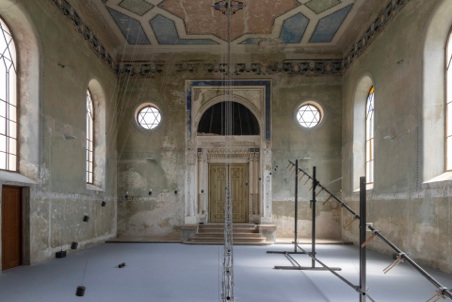


At Home Gallery 2023
………..
2.4.-27.4.2023
Kirsten Jäschke (GER) - artist-in residence
https://www.kirstenjaeschke.de/
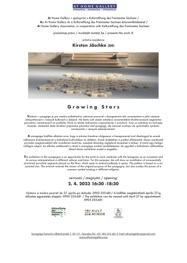
The exhibition in the synagogue is an opportunity for the artist to work creatively with the hexagram as an ornament and its various interpretations in different cultures and times. For this purpose, she will show an installation of ornamentally structured porcelain segments placed on the floor, which seem to extend endlessly in space. The pattern is based on a six-pointed star. The artwork reminds the viewer of the original purpose of the synagogue, but also evokes the power of a common symbol existing in different religions.
……….
4.5-9.6. 2023
Josef Baier (AT)
HearCurves -
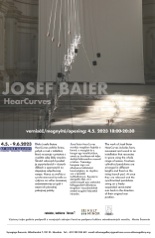
Josef Baier's work HearCurves incorporates form, movement and sound in an installation that resonates in space using the whole range of senses. Fourteen cylindrical pendulums are arranged in different lengths and fixed on the rising launch pad. At once they are released and the synchronized pendulums swing they swing on a freely suspended seven-meter axis back in the direction of their original resting position. A chord of 14 notes sounds as the piano hammers strike the finely tuned ones of sound tubes suspended on an aluminum rail rising in the middle space. Pendulums seem to draw a large curve in the air as they swing, but as they continue to swing, they lose their synchronicity and begin to draw smaller curves and oscillating lines in various patterns. At the same time, the chord breaks down into individual notes that strike at different times. For a moment, it seems that everything it dissolves into visual and acoustic chaos, but immediately the elements begin again arranged in perceptible arpeggios and curves until they finally end in a straight line with a single striking chord. After 2 and a half hours, the kinetic energy of the device consumes and everything stops completely. The work is aesthetically and acoustically engaging as the flying pendulums draw lines and dots that seem to float ethereally in space, and sounds reminiscent the bells make the movements abundantly audible. Through these tangible of sensory experiences natural laws and phenomena receive a three-dimensional form and the viewer is invited to ponder the deeper concepts, the ever-changing nature and the finitude of the human condition.
………
23.6.- 30.7. 2023
Sheri Wills & John Schettino (USA) -Assembly II
artist-in residence
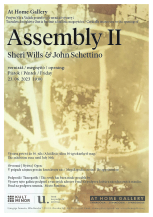
Assembly II
4-channel video (6-minutes looping); Wood and Mylar Construction; Sound (31-minutes looping)
Sheri Wills and John Schettino’s project, Assembly, is part of an ongoing collaborative series centered around acts of constructing, composing, and drawing together. The installation combines layers of light, line, and ordinary building materials into a layered panorama showing imagery that suggests moments that have been lost, erased, or buried, and the urgency of memory in the face of disappearance. In 2018, Juraj Turtev and Marta Galbáčová sang at the opening of Sheri Wills’s installation What Does Light Remember? Their remarkable performance becomes the starting point for the sound in Assembly. Following the instructions of American experimental composer, Alvin Lucier’s, I Am Sitting in a Room (1969), Sheri played the recording of their performance in her studio, and then re-recorded that recording and repeated that process eighteen times. Each recording has subsequently shaped and been re-shaped by the specific resonances of the room, as new sounds become incorporated into subsequent recordings. This piece is about what gets lost through re-telling, as well as about the lingering echo of past voices that constantly surrounds us. Like the sound, the 4-channel video utilizes repetition, layering, accumulation, and the artifacts that result from the build-up of imagery, repeated memories, and the forms that either emerge or are excavated from that work. The imagery in Assembly II is constantly in play, as soon as the bigger picture becomes visible it seems to slip away, like the lifelong project of struggling to be open to seeing clearly.
Assembly II adds another dimension to the installation in the upper gallery of the synagogue with another layered construction that further explores how we can see across scales and expand our limited understanding of life.
………..
9.8. - 3.9. 2023
Alison Safford (USA) - artist-in residence

Alison Safford (USA)
Avalanche
This piece started with my first visit to the synagogue in Šamorín in 2012. Above the ark of the synagogue is a fresco of the night sky, deep blue with golden stars. Time has eroded the stars either through human hands, the deterioration of the building materials, or likely both.
I think of the humans trying to make the stars their own, and the stories behind that. It is both a destructive and a hopeful act. This uncertainty creates stories for me. They are conflicting stories, as is often the way of real stories.
My installation puts humans back in the story of the stars. When rocking in the rocking chairs we are given time to meditate on the stars, and their disappearance. Our rocking causes the cello bows to slowly wear on the metal bar, gold chips falling and accumulating on the floor. The act is both constructive and destructive, as is often the way of real stories.
My last installation for At Home (A/Musing the Muse 2018), was a reflection on the 67P comet, its cycles, and wanting things that are unreachable to be closer. It also it rooted in my misinterpretation of Mliečnanská, the street At Home Gallery is on. The words translate to Milky Way in English, which I took as the Milky Way of the skies, not of the cows. There is a beauty in misinterpretation. This along with the UFO-like water tower in the distance, while a humorous misinterpretation, has always made At Home a place of convergence for me. This installation asks similar questions to A/Musing the Muse: how we make things that are unreachable reachable, how do we make them our own? Stars are light years away, yet terrestrially present. Can we have them to ourselves? And is there a cost in trying to attain the unattainable?
.............
21.9 - 18.10. 2023
and quiet that splinters the winter
A site-specific installation
Denise Hawrysio and John Wynne (UK-CA)
The title of this installation is from a poem by Anastasia Afanasieva, one of many contemporary Ukrainian writers exploring how – and if – poetry can respond to the Russian invasion of their country. Hawrysio and Wynne worked together in the At Home gallery throughout September, experimenting with materials and media to ask the same question of art.
The devastating effects of this war on nature are catastrophic, and mirror the simultaneous human tragedies and physical destruction wrought by the pointless aggression. As Yevheniia Zasiadko from Ecoaction, a Ukrainian environmental group says, “War affects our nature just as badly as our people and our infrastructure. However, this damage remains unseen and mostly ignored, for the environment is the silent victim.”
Using sound and projected images, the artists use the forest as both a literal and metaphorical representation of the effects of war, while a set of collages bring the focus more specifically on the current conflict.
Hawrysio’s family were part of the early 20th century Ukrainian diaspora in Canada, and she grew up hearing her grandmother’s stories of the traumatic circumstances that caused her to leave Ukraine. Since February 2022, both artists have felt compelled to search for ways to respond to the atrocities in Ukraine through their work. As Vincent Lloyd writes, “The inertia of the ordinary sweeps us along, muting all but the most mundane worries. But in moments of tragedy, of deep decision, of disruption, of evil, in moments when we step out of the pull of the ordinary, we understand that something is amiss in the world.”
As well as engaging with the effects of the Russian aggression and exploring how art can respond to such traumatic and disturbing realities, the artists’ work responds to the history and architecture of the gallery itself – a former synagogue built by the Slovak Jewish community in the early 20th century which was subsequently used as an ammunition store by the Nazis during WWII.
and quiet that splinters the winter holds menace and beauty in a kind of cognitive dissonance. It is both a gesture of remembrance for those who have died and a lament for the natural environment.
Denise Hawrysio website: www.hawrysio.com John Wynne website: www.sensitivebrigade.com
27.10 - 26.11. 2023
IN SITU (SK)
globalocal
ARADSKÝ Richard, EGERVÁRI Júlia, FERDICS Béla, FUNCZIK Mónika, GYENES Gábor, Mazán Anikó, NAGY Csilla, PÁLMAI László, PÉZMAN Andrea, SLÁVIK Bernadett, SZŐKE Erika, TÖRÖK Bianka, VÁCLAV Kinga,

IN SITU is an artistic group that creates at the symposium of the same name in the village of Vojka nad Dunajom. The village of Vajka, on the Slovak side of the inner Danube delta region, is situated on an artificially created Danube island, between the old Danube riverbed and the water intake canal of the Gabčíkovo hydroelectric power station. The clash of floodplain nature and technology, isolation (the island‘s inhabitants are linked to the Žitný ostrov by a ferry) and dynamic population change (the decline of indigenous villagers and the rapid influx of urban population from Bratislava) all provide themes for artistic expression. This is what IN SITU, a group of artists and architects, is attempting to do in the language of nature art and site-specific art.
They mainly create ephemeral objects, installations and performance art, which are documented in photographs and videos. They prefer natural, degradable materials in creation, and try to minimize inputs and maximize conceptual statements. The goal of the group is a critical treatment of the topic of human encroachments on nature, mapping the global consequences of human activity at the local level.
………
